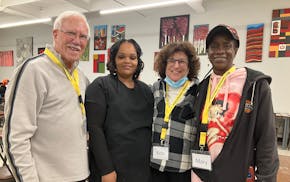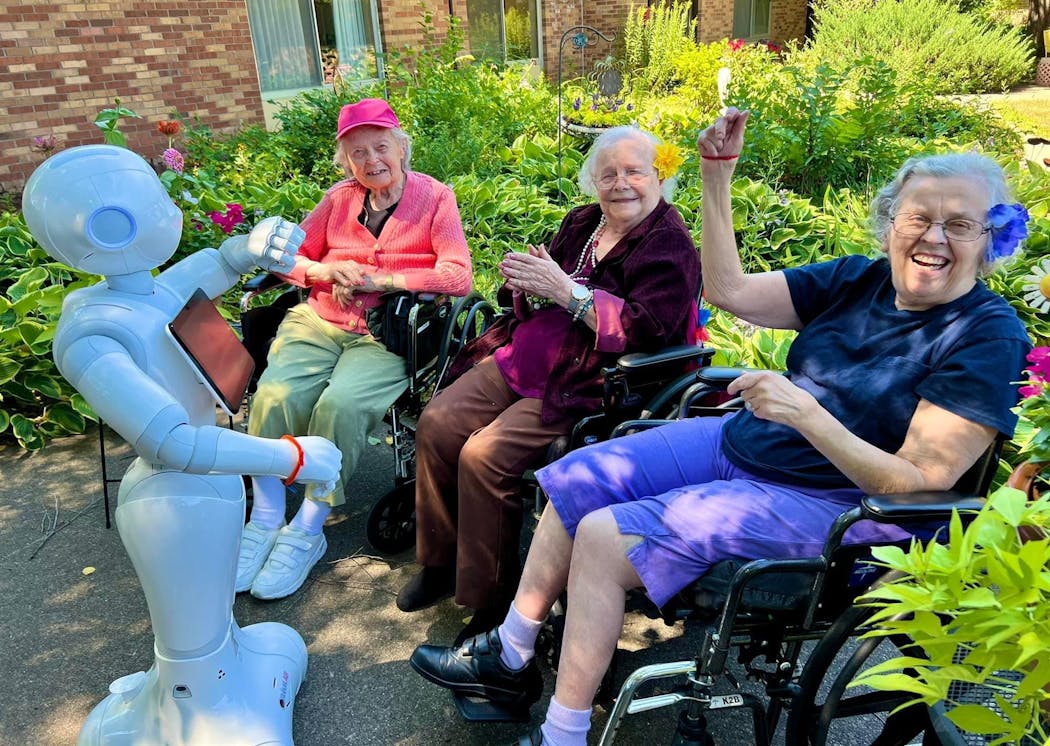A half-dozen women and men are sitting around Pepper, who is dancing to Elvis Presley's "Jailhouse Rock."
Pepper is a 4-foot-tall robot entertaining an audience mostly in wheelchairs at The Estates at Roseville. The nursing home uses Pepper to keep some of its 55 memory care residents engaged while waiting for activities.
"I like the robots, but I don't like [their] jokes," said Estates resident Deborah Scott, 68, who just had her nails painted glitter-red. She said she likes having something fun to occupy her before or after her manicure.
From independent living to memory care centers, residential facilities across Minnesota are adding smart technologies to make life easier, safer and more fun for residents and their caregivers.
"We clearly have a bit of a renaissance when it comes to technology in our field," said Kari Thurlow, president and CEO of LeadingAge Minnesota, an association of care providers. "The sky is the limit."
The burgeoning trend ranges from digital signage and wearable devices to health monitoring and robots. Such technology can help improve people's moods, prevent falls, lead to earlier detection of infections, and enhance connections.
Nationally, more organizations geared toward older adults invested in automation and artificial intelligence (AI)-based tools last year, according to a Ziegler survey. They expect to invest more in those as well as high-speed connectivity, wander management systems and fall detectors in the future.
Smart technology for such communities is so nascent that there are no industry standards on the national or state levels.
"We see them putting in smart bidet toilets, Alexa Skills or companion robot dogs, but it's not across the board," said Lisa M. Cini, a long-term care design expert and author of three books based in Columbus, Ohio. "It's market-driven and competition-driven."
As older adults and their families shop for housing options, experts suggest they ask what type of smart technologies are in use, and what is the site's policy if you want to bring your own technology, such as an Alexa virtual assistant or wearable device.
Starting simple
At Amira Choice Bloomington, you might see iPads mounted outside its 24 memory care apartments to help residents find their way to and identify their room. Families send photographs, which the staff uploads to create a slideshow.
"It helps with the familiarity of a new environment," said Alees Gleason, executive director of Amira Choice Bloomington. "Residents don't get lost and don't necessarily go in rooms that aren't theirs."
Photos on the iPads also can help staff or residents start conversations about their family or places they've visited, said Donna Flaata, director of senior housing development for Great Lakes Management, which operates Amira Choice Bloomington.
Monitoring health
When you walk into a memory care room at Talamore Senior Living Woodbury, you may not notice the small box mounted near the ceiling. It's a depth sensor that monitors movements in the room, which appear as outlines, said executive director Breanna Bruce.
It's part of Foresite Healthcare's predictive health-monitoring system that Talamore Woodbury uses in its 26 private memory care rooms and 14 enhanced care rooms. Another sensor below the mattress monitors vital signs like body temperature and heartbeat. A motion sensor in the bathroom tracks the number of visits.
When a new resident moves in, the sensors take up to two weeks to build an algorithm of the person's vital signs and mannerisms, such as their heart rate, temperature and walking gait, Bruce said. A change in gait may signify an increased risk of a fall. Extra trips to the bathroom may signal a urinary tract infection.
Each morning, Foresite sends a status report for every room to the staff. The AI-based system sends staff alerts sooner for changes it deems emergencies, such as a fall, she added.
In one recent case, Foresite alerted the staff when a resident fell. The resident didn't have a clear memory of the fall, but the depth sensor footage showed that she tripped while walking backward, fell and hit her head. This allowed for better diagnoses and care at the ER and back at Talamore, Bruce said. "We can put preventions in place so it doesn't happen again," she added.
Since March, Foresite has captured eight falls, with staff responding to each within two minutes, she said.
Families like the real-time alerts and quick response time, said Mariah Lee, director of nursing at Talamore Woodbury. "It's an added level of security with shrouded dignity — that's what they really like about it," she added.
Catholic Eldercare is remodeling its two assisted living buildings in northeast Minneapolis, which includes installing sensors in the refrigerators and bathrooms, said Tom Glass, director of the community's foundation. The nonprofit also is thinking about introducing wearable technology to its adult day-care members.
Follow the robot
Residents eating lunch at Hayden Grove Senior Living communities in Bloomington and St. Anthony may get their food served to them by a robot that says "Enjoy your meal." The 80 residents at Hayden Grove's St. Anthony location, which opened in February, named their 3.5-foot-tall robot "Otto."
"The residents get a kick out of it," said Kristel Lastine, executive director of Hayden Grove St. Anthony. Beyond the fun aspect, Otto's five trays can serve an entire table at once, and it can clear a table faster than a person, she said.
"Basically, it allows us to provide better customer service in the dining room so [staff] can focus on the residents," Lastine said. "The staff can talk with residents more, socialize more. The robot just improves overall efficiency."
Other robots in use at communities in Minnesota also vacuum and teach yoga, among other tasks.
Residents of eight Monarch Healthcare Management communities in Minnesota, including The Estates at Roseville, have interacted with robots for up to 15 months in collaboration with Arshia Khan, a computer science professor at the University of Minnesota Duluth.
Each location has two robot models manufactured by Aldebaran, a division of United Robotics Group — the four-foot, humanoid Pepper and the two-foot "NAO" model that looks like a mini "Star Wars" Stormtrooper. Pepper can play music, dance (it likes the Macarena), speak limited words like "Good morning," and tell basic jokes. The NAO robot, which residents voted to name "Rosie," leads yoga sessions.
"I love it," said Quasim Edwards, 76, about Pepper at The Estates at Roseville. "It's almost to the point where it can almost think on its own."
All of Monarch's robots are in its nursing homes because most of the funding — it received about $900,000 — comes from a state grant program for nursing homes.
"We are using them to enhance the residents' well-being and social engagement," said Marcus Kubichek, robot program director for Eagan-based Monarch. "It's a popular activity in the novelty of a robot. Residents will dance and sing along with the robot."
In the future, Khan said she hopes to program beyond social engagement and well-being checks for use that may entail facial recognition, verbal communication and navigation.
"The hope of the future is that [robots] will free up staff to do something else, but not right now; you need to issue commands to the robot," Monarch's Kubichek said. "With advancements in AI, there will be so much more."
Mapping the future
Older adults will find that smart technology varies greatly from community to community. While some features are being added to existing buildings, industry experts said it's often easier to include them in new construction, such as at Hayden Grove St. Anthony and Talamore Woodbury.
"All of this technology is unbelievably expensive," Catholic Eldercare's Glass said. "Some of this technology is great, but how do we pay for it?"
Minnesota is different than most other states because the state sets monthly rates for nursing homes. The average cost in Minnesota of assisted living was $4,508 a month, and nursing home care was about $13,000 in 2021, according to the Genworth Financial 2021 Cost of Care Survey. Costs were higher in the Twin Cities.
To help care providers navigate which smart technologies are best for them, the LeadingAge Minnesota Foundation is creating a free digital resource that will be available early next year for members.
"Overall, these investments get baked into the total cost of care," said Thurlow of LeadingAge. "What we don't know is if it may prevent higher costs in the long run if [the technology] is preventing hospitalizations and resulting in earlier interventions."
News anchor Poppy Harlow announces departure from CNN
Orange crush: Boats packed with revelers tour Amsterdam canals to celebrate the king's birthday



